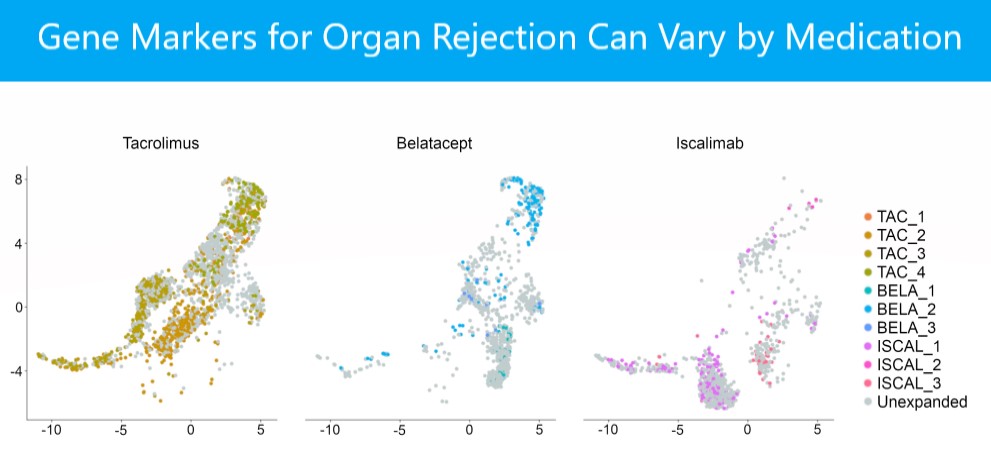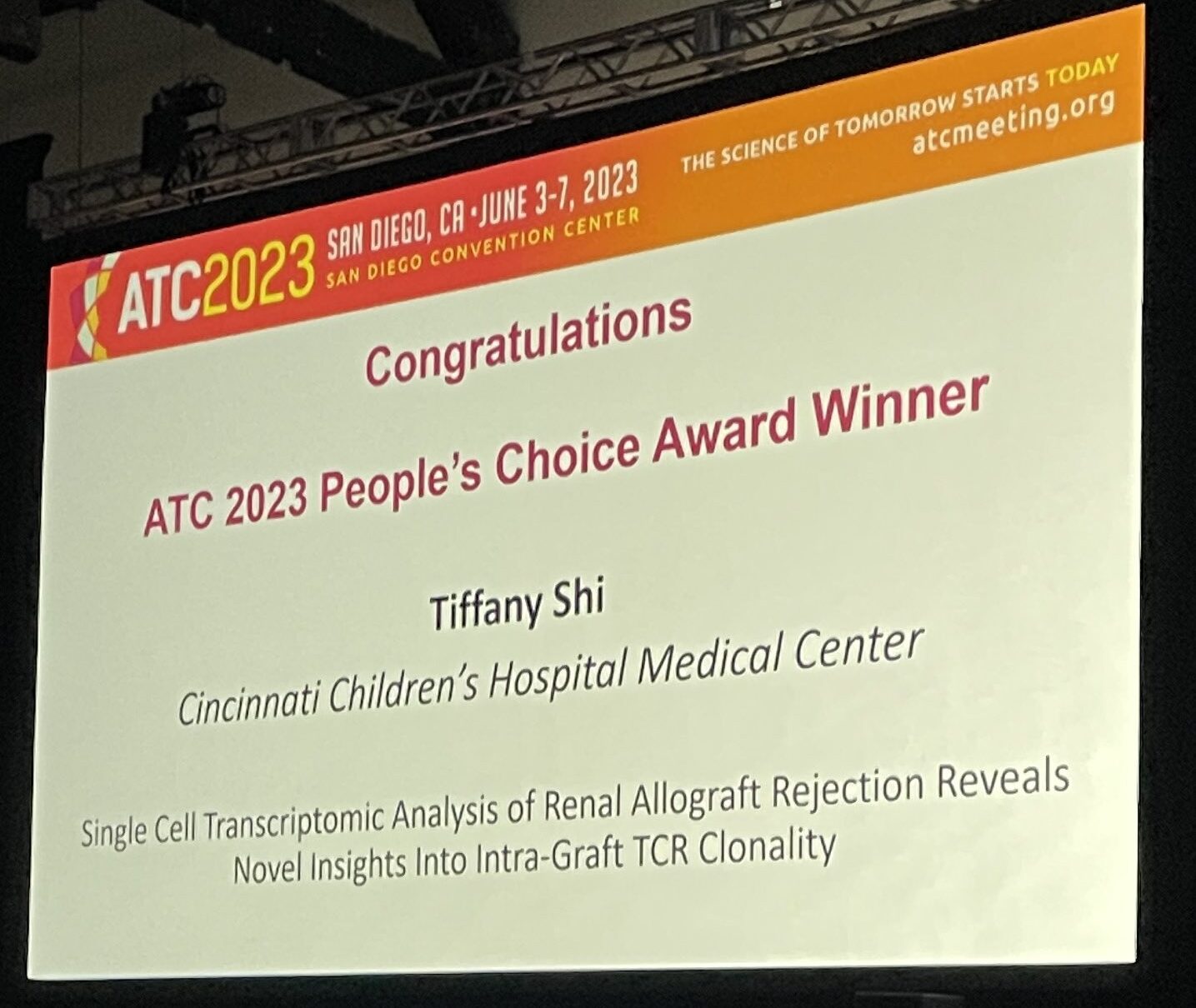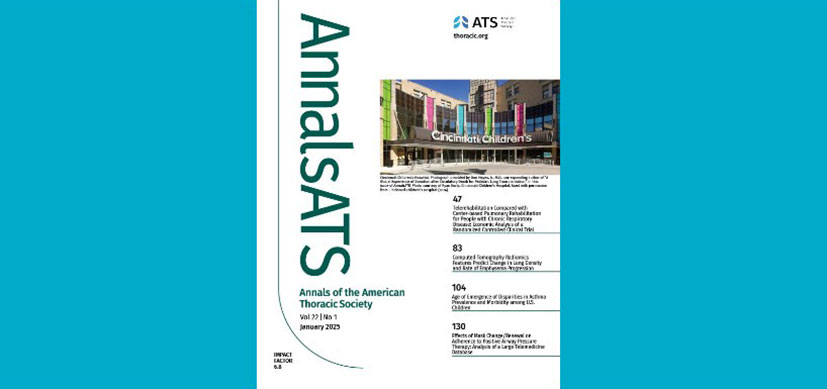Research Reveals Novel Insights into Transplant Rejection and New Drug Development Targets
Research By: Tiffany Shi, MD/PhD student | David Hildeman, PhD | E. Steve Woodle, MD
Post Date: June 28, 2023 | Publish Date: May 25, 2023
Immunobiology | Top Scientific Achievement


Groundbreaking study led by researchers at Cincinnati Children’s and the University of Cincinnati identify new drug development targets and potential urine test
Imagine a day when a urine test could inform a doctor precisely why a kidney transplant patient was experiencing organ rejection and suggest the best medication for specifically addressing the problem.
That day took a leap closer to reality thanks to a remarkable set of single-cell analyses that have identified the most specific cellular signatures to date for kidney transplant rejection. The findings were detailed May 25, 2023, in JCI The Journal of Clinical Investigation.
The study results reflect eight years of teamwork led by experts at Cincinnati Children’s and the University of Cincinnati College of Medicine with contributions from researchers at the University of Notre Dame and Novartis.
Tiffany Shi, an MD/PhD student with the Immunology Graduate Program and Medical Scientist Training Program at Cincinnati Children’s was first author. Senior co-authors were David Hildeman, PhD, interim director of the Division of Immunobiology at Cincinnati Children’s, and E. Steve Woodle, MD, professor of surgery and William A. Altemeier Chair in Research Surgery at the UC College of Medicine. Hildeman and Woodle co-direct the Center for Transplant Immunology at Cincinnati Children’s.
“The available treatments for stopping a rejection event have not changed much in decades. These cellular signatures open the door to establishing an entire new set of anti-rejection therapies,” Hildeman says.
“Having a precision-medicine approach to treating organ rejection has the potential to markedly reduce the threat rejection poses to transplanted organs,” Woodle says. “More follow-up research will be needed, but these findings have implications that extend beyond kidney transplantation to potentially apply to liver, lung transplantation and more.”
Organ rejection affects 10% of recipients
Kidney transplantation is the most common form of organ transplant; provided after organ failure from diabetes, infections, injuries and other factors. In 2022, surgeons performed 25,498 kidney transplants across the US, according to the United Network for Organ Sharing (UNOS).
Over the past 30 years, gradual improvements have allowed kidney transplants to last longer so that now the “half-life” for living-donor kidneys exceeds 20 years and approaches 12 years for deceased-donor organs.
“For an older person, these survival rates reflect a pretty long time,” Hildeman says. “But for younger adults and children, the chances of needing a second transplant remain high.”
However, once a kidney transplant recipient experiences acute rejection, many go on to lose their transplant and return to dialysis within 1-3 years. In addition, once a patient’s immune system rejects one organ, it is much more likely to reject a second transplant.
Unfortunately, the tools available to effectively treat rejection–corticosteroids and antilymphocyte globulins–have remained largely unchanged for over 60 years. Evidence accumulated over many years has indicated that these treatments inadequately or incompletely treat rejection.
Discovering clues one cell at a time
In the new study, researchers used powerful single-cell genomic analysis technologies to painstakingly compare biopsy samples from transplanted kidneys that encountered acute cellular rejection. The studies also compared rejections occurring under the commonly used maintenance immunosuppressive agent (tacrolimus) and two newer alternative medications (belatacept and iscalimab).
The analysis was so detailed that the team was able to track how gene expression changed within specific populations of cells that drive rejection damage, which the authors termed allospecific CD8 expanded T cell clones (CD8EXP).
The researchers say this study is the first to apply a combination of single-cell RNA analysis with single-cell T cell receptor (TCR) analysis to explore acute kidney transplantation rejection.
“The power of what we’re doing comes from being able to look at cells on a single-cell level. We can look specifically at the ones that are responsible for rejection and we can look at how rejection changes over time as the T cells are shifting their response to different drugs,” Shi says.
Woodle describes CD8EXP cells as the “tip of the spear” in rejection.

The work revealed three key findings:
First, even when an acute rejection event was stopped, the research revealed that treatments often are not thorough enough to eliminate all the T cells that had cloned themselves to attack the transplant. In some cases, hostile T cells persisted for months after anti-rejection treatment.
This suggests that multiple rejection events, previously believed to be entirely separate, may actually be one, longer, smoldering rejection event. Addressing lurking cloned T cells that eluded initial treatment will likely require improved testing techniques and adopting more consistent practice standards.
Second, the team found roughly 20 “clonotypes” of CD8EXP T cells–from a potential of thousands–that reproduced themselves to mount attacks against a transplanted organ. The types differed according to the receptors the T cells carried. The relatively low number of clonotypes excited the researchers because it will make it easier to search for potential new treatments to stop transplant rejection.
By studying these rare, but efficient cells, the team found distinct cellular signatures occurring during a rejection event that varied depending upon which maintenance immune-suppression drug was used. The different genes involved raise the possibility of using other medications not typically associated with treating organ rejection as new weapons for specific situations.
For example, this team also recently reported success at using an mTOR inhibitor called everolimus to help patients that did not benefit from belatacept treatment But that same drug appears to offer no similar benefit when tacrolimus treatment is involved. This work led to a currently ongoing clinical trial led by Woodle to treat patients with belatacept and everolimus for maintenance immunosuppression.
Third, the same T cell types causing rejection events also can be detected in urine samples.
Why a urine test matters
Currently, obtaining the crucial details underlying rejection of a transplanted kidney requires collecting a tissue biopsy, a surgical procedure that requires visiting a hospital. Conducting multiple biopsies over time to track treatment outcomes is expensive and potentially risky for patients.
However, urine tests could be collected more frequently in a non-invasive manner and potentially without the inconvenience of visiting a hospital. In addition to directly supporting patient care, a viable urine test would help accelerate the research work required to evaluate new anti-rejection treatment protocols. The research also demonstrated that CD8EXP T cells that were found in the rejecting organ were also present in the urine.
“This finding indicates that a simple urine test could substitute for a more invasive kidney transplant biopsy and thereby make it much safer and easier for patients to have their rejection treatment monitored for effectiveness,” Hildeman says.
The critical challenge for achieving a practical clinical urine test will be to establish a process that can produce test results in 48 hours rather than the research-focused process used in this study, which took several months to complete.

Award-winning presentation
As first author, Shi presented the results from this study at ATC2023, the annual scientific meeting of the American Transplant Congress, held June 3-7 in San Diego. Shi’s presentation received the “People’s Choice Award,” which means it was selected by the 5,000-plus attendees as the best plenary presentation of the meeting.
Shi also received a Young Investigator Award and several other Cincinnati Children’s and UC researchers were honored at the event.
Next steps
Additional research work is needed to explore treatment possibilities related to the T cell signatures revealed in this study. Work led by co-authors has already shown that tacrolimus was a very good treatment for some patients with resistant rejection cases.
Longer term, the benefits could reach beyond expanding the “half-life” of donated kidneys.
For example, finding alternatives to tacrolimus could help people with liver transplants and other organ transplants avoid kidney complications from their anti-rejection regimens.
And eventually, new understanding of the key cellular mechanisms involved in transplant rejection could lead to methods to reduce the risks of xenotransplantation (using gene-modified animal organs in humans).
“Most people who need an organ transplant never receive one because the supply of donated organs remains so limited,” Woodle says. “Thanks to insights like these, we may be able to substantially reduce loss of transplanted organs to rejection, thereby freeing up donated organs for new transplant recipients.”
About the study
In addition to Shi and Hildeman, Cincinnati Children’s co-authors contributing to this study included: Ashley Burg, PhD, Krishna Roskin, PhD, J. Timothy Caldwell, MD, PhD, and Cyd Castro-Rojas, PhD.
In addition to Woodle, University of Cincinnati contributors included Rita Alloway, PharmD, and Adele Shields, PharmD.
Funding sources for this study included a grant from Novartis and Public Health Service grants from the US Department of Health and Human Services (AI167482, AI142264, UH2AR067688, UL1TR000077, and AI169863).
More 2023 Research Highlights
Chosen by the Division of Immunobiology
Eshleman EM, Shao TY, Woo V, et al. Intestinal epithelial HDAC3 and MHC class II coordinate microbiota-specific immunity. J Clin Invest. 2023;133(4):e162190. Published 2023 Feb 15. doi:10.1172/JCI162190
Overcast GR, Meibers HE, Eshleman EM, et al. IEC-intrinsic IL-1R signaling holds dual roles in regulating intestinal homeostasis and inflammation. J Exp Med. 2023;220(6):e20212523. doi:10.1084/jem.20212523
Cazares TA, Rizvi FW, Iyer B, et al. maxATAC: Genome-scale transcription-factor binding prediction from ATAC-seq with deep neural networks. PLoS Comput Biol. 2023;19(1):e1010863. Published 2023 Jan 31. doi:10.1371/journal.pcbi.1010863
Ghosh, Debajyoti et al. Maternal Exposure To Phthalate Drives Skin Changes Associated With Increased Susceptibility To House Dust Mite Induced Atopic Dermatitis In Offspring. The Journal of Allergy and Clinical Immunology. 2023;151(2):supplement. Published 2023 February. doi:10.1016/j.jaci.2022.12.468
View more discoveries from 50 research divisions and areas
Return to the 2023 Research Annual Report main features
| Original title: | Single cell transcriptomic analysis of renal allograft rejection reveals insights into intragraft TCR clonality |
| Published in: | Journal of Clinical Investigation |
| Publish date: | May 25, 2023 |
Research By


The Hildeman Lab studies the molecular mechanisms controlling T cell development and homeostasis.








